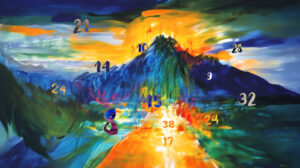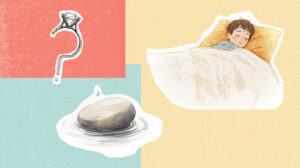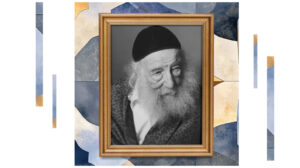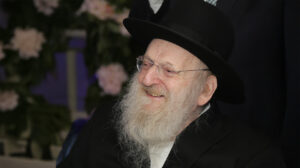In a Forgotten Graveyard
| November 9, 2011Rebbe Gedalya Moshe was buried in one of the tiny graveyards in a corner of the city. Who knew of it’s power?
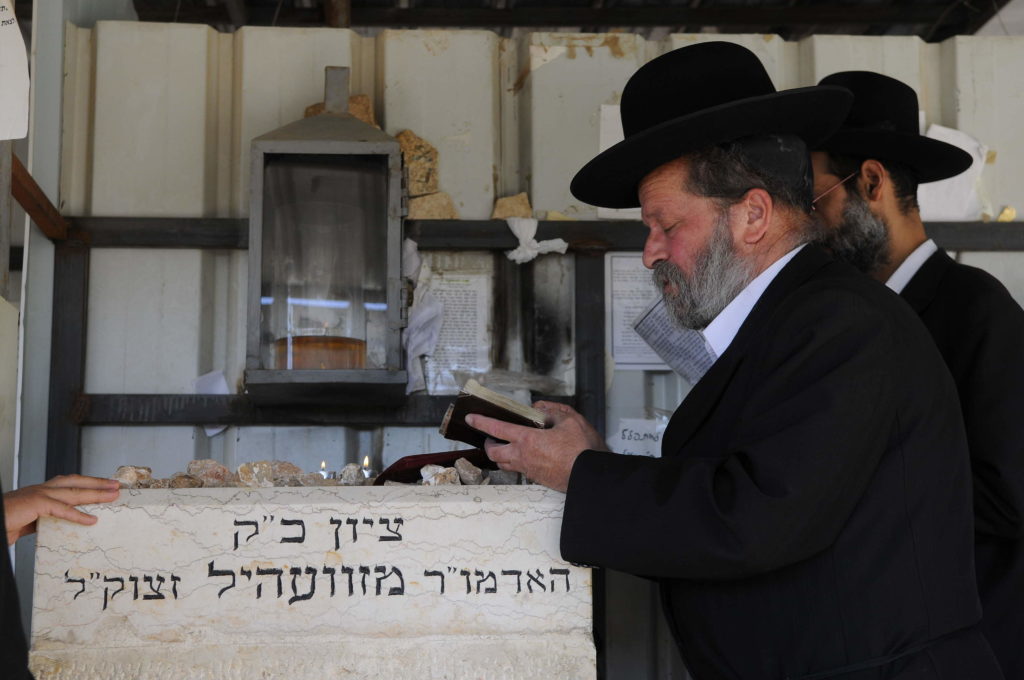
A FACE AND A PLACE
Pinchas Kornfeld | The Segulah Grave
On a Monday morning four years ago, he made his way to a forgotten graveyard outside the Knesset with a jerry can of water and a mission. Rav Pinchas Kornfeld was determined to locate the grave of the legendary Zviller Rebbe — and find it he did, along with an astoundingly efficacious segulah. It’s years later, but he’s still a faithful face at the site, praying for yeshuos every Monday, Thursday, and Monday … along with many others who’ve discovered the secret.
Her hair is frosted, her police uniform — light blue, short-sleeved shirt; dark blue pants — is immaculate. Her revolver is holstered firmly at her side. She strides with the confidence of a woman who holds onto power as securely as she wields the nightstick on her belt.
Moments later, bent in humble prayer, a tear or two sparkling on her cheeks, she joins the Yerushalmi women, the Bais Yaakov girls, and me, at the kever of Rav Gedalya Moshe, the Zvhiller Rebbe ztz”l.
The 1948 War of Independence was over, ending in a fragile, tenuous truce. Tiny Israel had miraculously survived the onslaught of Arab armies, but with losses, terrible losses. One percent of the Jewish population was dead. The Jews were once again exiled from their holiest places: the Kosel, Kever Rochel, Mearas HaMachpeilah were all in Arab hands. Even the dead were banished from their rightful abode: Har HaZeisim, the ancient Jewish cemetery, was left to the brutal Jordanian forces.
Life goes on, and so does death. For three years, when the Har HaMenuchos cemetery was finally opened in 1951 for Jerusalem’s Jews, those who died in Yerushalayim were buried in tiny graveyards set up in little corners of the city. One of those small graveyards, home to perhaps 200 souls, was consecrated in a forgotten little corner not too far from the city’s shuk.
And there, more than for half a century, the dead slumbered in silence.
For Another Jew
I am writing this article to fulfill a promise “l’farsem,” to publicize the yeshuah, the help that I received from Hashem. There was a boy, a son, beloved, with a spark of zest and mischief in his eyes. Somewhere on the road through adolescence the spark dimmed and the beloved son became what we like to euphemistically call a kid-at-risk. If you’ve worked with young men and women like this, if you’ve lived with them, you know all that the term means: the sleepless nights, the agonizing questions, the recriminations, the doubts, the tough choices, the tears. And the prayers.
About a year ago I learned of a place that has become, in just a few short years, a place of serious tefillah for hundreds, sometimes thousands, who daily come to beg Hashem for yeshuah: the kever of Rav Gedalya Moshe ben Rav Shloimke, the Zvhiller Rebbe.
Son of the famed Rav Shloimke of Zvhill, Rav Gedalya Moshe was an ilui, a Torah genius who could do the “pin test” — if you would insert an imaginary pin in any word of a daf of Gemara, he could tell you which words would be pricked in all the following dapim. He was appointed rav of Zhvill, in White Russia, when he was only eighteen. It was when in exile in Siberia, though, that his greatness became even more apparent; in more than a decade in the wild and frozen wasteland, he never missed putting on tefillin, and never desecrated Shabbos. Only once, he came close.
From his home in Palestine, Rav Gedalya Moshe’s father, Rav Shloimke of Zvhill, put in massive efforts to redeem his son. Finally, the orders to free Rav Gedalya Moshe, as well as another banished Jew, came through. It was on a Shabbos when the two Jews were called into the commander’s office. There, they were ordered to sign papers that would ensure their release. Rav Gedalya Moshe refused to sign on his holy day. But when the other Jew followed his example, refusing to desecrate Shabbos, Rav Gedalya Moshe insisted that he do so, because it was a case of pikuach nefesh — the man was older, and it was clear he would not survive long in Siberia. “If you will not sign,” Rav Gedalya Moshe told him, “I will sign on your behalf, in order to save your life.”
Seeing this self-sacrifice, the ice that had ringed the heart of the Siberian commander melted a little, and he allowed both men their freedom — without making them desecrate their holy day.
Leaving Siberia, Rav Gedalya Moshe joined his father in Palestine, and after Rav Shloimke’s death reluctantly assumed the position of Rebbe. Rav Gedalya Moshe ztz’l died in 1950, and was buried in one of the small graveyards set up in the city after Har HaZeisim fell into Jordanian hands.
In the six decades since his death the city had grown around the tiny cemetery, and now the area is surrounded by icons of Israeli culture and power: the Supreme Court to its right; the Knesset building a few steps away to the left; the scenic Wohl Rose Garden and popular Gan Sacher, Israel’s equivalent of Central Park, flanking it on its other sides. But with all these tourist attractions, the Jewish People know instinctively where the action is, and it’s this quiet little cemetery that brings in the masses.
I arrive early in the morning and there are already dozens of people here. The grave itself is on the edge of the cemetery, and a mechitzah allows men and women to daven in tzniyus and privacy. Laminated sheets, some of then in English and French though most, of course, in Hebrew, give instructions. Visitors are told to say specific pirkei Tehillim, to put a stone on the grave, to give tzedakah, to light a candle for the soul of the tzaddik (there are two large metal bins aglow with the flames of hundreds of tea lights), and to plead for one specific yeshuah. These instructions are to be followed on a consecutive Monday, Thursday, and Monday. When Hashem grants the yeshuah, the visitor should return “l’vaser,” to “tell” the tzaddik, and “l’farsem,” to publicize it.
In a very short time this forgotten corner has become a place of pilgrimage and tefillah. How did it happen?
Not surprisingly, it began with a story.
He Can Help You
In 1948, the Beis Yisrael neighborhood was under attack from nearby Jordan. To stick one’s head out of the window was to risk death, and most of the population huddled in the public shelters.
Death in another guise was already stalking one home in the area. The young wife of Rav Chaim Brim, only 26 years old and mother of a growing family, was dying of an
illness. “There is nothing we can do but warn the Kohanim to leave the building,” the doctors told him.
The distraught husband raced to the home of Rav Dushinsky for help. “Go to Rav Gedalya Moshe,” he told him. “Ask him to help you.”
Ignoring the shells falling around him, Rav Chaim went to the Zvhiller Rebbe’s humble apartment. “What can I do?” Rav Gedalya Moshe told him. “My father was an ish kadosh, a holy man whose blessings were powerful; I am just a humble Jew.”
Rav Chaim returned to Rav Dushinsky’s home. “Tell him that I, as mara d’asra of Yerushalayim, command him to help you,” he declared.
If the rav commands … the rav heeds. Rav Gedalya Moshe gave swift instructions. “Go to the bomb shelter and get 50 women together. Each should sign that they will give your wife one year from their lives. Tell the women that in the merit of this mitzvah, I guarantee they will live long and survive this terrible war.”
The women of Beis Yisrael were huddled together in a stuffy public shelter. Rav Chaim made his unusual request. Within minutes he had to tell the women to stop—– he had more than fifty women ready to give over a year of their lives!
In his apartment, a few minutes after the document was signed in the shelter by the women, Rav Gedalya Moshe turned to his gabbai. “I think she’s better,” he said.
Rav Chaim’s wife lived to the age of 76, fifty more years. And every one of those women survived and went on to live long, full lives.
Four years ago Rav Pinchas Kornfeld, a Gerrer chassid from Yerushalayim, heard this story from a friend. Interested, he asked where Rav Gedalya Moshe was buried, and the friend told him about the little, almost forgotten graveyard near the Knesset. Rav Pinchas visited, and was horrified by what he saw: “Everything was neglected, dirty, full of weeds. There is a bird watching station nearby, and the place was full of dead birds.”
Not long afterwards, Rav Pinchas told me, a close relative confided that she was distraught; one of her children was having problems with finding a shidduch. Rav Pinchas had an idea: “I took a jerry can of water with me, found the kever, and cleaned it up as much as I could. Then I said pirkei Tehillim and put a note and a rock on the gravestone. This was a Monday, and just before I left I said — I will do this on Thursday too.” Rav Pinchas did, indeed, return on Thursday, and then on the following Monday.
“And on Tuesday,” he told me, his voice triumphant, “we celebrated her child’s l’chayim.”
There was another child in the family, also looking and not finding. Again, Rav Pinchas went on Monday, Thursday, Monday; again, the engagement was celebrated the very next night. A third time, Monday-Thursday-Monday led to a Wednesday night engagement, while the fourth time led to two engagements in the same family — one Tuesday night, one Wednesday.
After that fifth engagement took place, Rav Pinchas realized this was something that he had to publicize. Within months, the word was out: This is a place of great holiness, where Hashem answers prayers.
When the Zvhiller’s yahrtzeit came around, Rav Pinchas decided it was time to make the area more accessible. “I am opening a gate and building steps to get in,” he declared, and he showed up at the site with a drill and two truckloads of dirt.
Well, you don’t show up a few yards from the Knesset with a drill and two truckloads of dirt without exciting a bit of attention. “Within a minute there was a security guard there,” Rav Pinchas laughs. Rav Pinchas explained that a tzaddik was buried there, and he was going to fix the area up. At the guard’s request, he showed his identity card, and when asked if he had permission, he replied, “Of course.” That’s when things got interesting:
“He picked up his radio and called someone, gave them my name and ID number. He spoke for a minute, then he turned to me: ‘You’re right, you do have the authorization.’ To this day I don’t know who he talked to.
“I broke through to make a gate and then I came back the next week, this time with a bulldozer. The security guard just came by, said hello. ‘Is that your bulldozer?’ he asked. When I said it was, he said, ‘Okay, fine,’ and the work continued.”
Beyond the Weeds
I am always profoundly moved by this place. There is a seriousness here; no chatting, everyone concentrating on their tefillos. There is also an almost palpable feeling of achdus: henna-haired women in short sleeves and pants stand quietly next to Yerushalmi women wearing black shawls, everyone wrapped in their thoughts, their prayers. In Jerusalem there is a tradition of bringing food when one’s prayers have been answered, and almost every time I have come there is a small table buckling under its load of rugelach, juice, and garinim, the ubiquitous Israeli sunflower seeds. The mechitzah is decorated with handwritten notes, in Hebrew, l’farsem; a litany of sorrow and hope and answered prayers (the translation is mine):
- I had a big loan I couldn’t repay, it was cut by 10 …
- I needed a place to live … I found it.…
- I was helped with true shalom bayis … after much time and suffering …
- … for a sick family member … who got well …
- I davened for joy. I had serious depression. Now I no longer stay in bed all day, I am no longer full of fears …
- After 7 years my daughter merited a child …
And as for me? With thanks to Hashem, there was a yeshuah. The sparkle returned to my young man’s eyes, and as I stood beneath the chuppah next to him, seeing him glow with happiness and holiness and hope all at once, and watched his beautiful kallah walk towards us, I thought of those who had seen us through the rocky times and accompanied us to this day: the rabbanim whose counsel guided us, the professionals whose wisdom enabled us understand what was happening, the friends whose support helped us cope — and, even more important, the Avos whose merit we invoked, the tzaddikim whose kvarim we visited, and in whose zchus our tefillos were answered, and, of course, HaKadosh Baruch Hu, at our side always.
As I heard the story of Rav Gedalya Moshe’s kever, standing forgotten and neglected until just a few years ago when its kedushah was finally revealed, I realized that this great tzaddik and our “kids at risk” have more in common than you would believe. Like the gravestone of the tzaddik, these kids in their cut-off jeans, nose rings, and in-your-face attitude look neglected, unloved, unimportant. But if we take the trouble, as Reb Pinchas did, to clean off the bird droppings, to look beyond the weeds and the discarded Coke cans, who knows what holiness we might yet find?
Author’s Note: I would like to thank R’ Deitsch of Mosdos Zvhill, and Rav Pinchas Kornfeld, for sharing their fascinating stories. I had one hesitation when asking Mishpacha to publicize the power of prayers at this site. With Mishpacha’s tens of thousands of readers, I am certain that many who hear about this will want to come and daven here. I ask all of you to remember that this is not a tourist attraction. I have visited it many times, and have never seen anyone taking pictures or talking on cell phones. My personal belief is that the power of the place derives both from the kedushah of Rav Gedalya Moshe, and from the seriousness of the prayers being said. Please, please keep this a place of prayer and not a fun spot to tell your friends about or a backdrop to a photo. And may all our tefillos be answered speedily.
(Originally featured in Mishpacha, Issue 380)
Oops! We could not locate your form.
